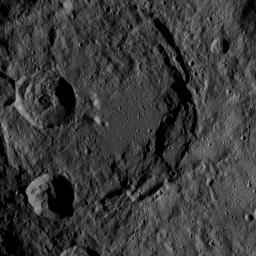
|
Dawn HAMO Image 59
- Click the image above for a larger view
- Full-Res JPEG (1024 x 1024) (194.1 kB)
- Full-Res TIFF (1024 x 1024) (1.1 MB)
Caption:
This image of Ceres, taken by NASA's Dawn spacecraft, shows a giant, ancient impact crater with smaller craters in its interior. The large crater shows partial terracing on its southeast rim, whereas the north part is almost fully degraded. Terraces -- generally level areas separated from lower areas by steep slopes -- are common features in large impact craters. The crater's floor is partly covered by smooth material.
The smaller crater in the south (lower left) is the freshest impact seen here. The distinct rim of the young crater, along with impact ejecta, covers part of the big crater's floor.
The image was taken on Oct. 3, 2015, from an altitude of 915 miles (1,470 kilometers), and has a resolution of 450 feet (140 meters) per pixel. The image is located at 53 degrees south latitude, 1 degrees east longitude.
Background Info:
Dawn's mission is managed by JPL for NASA's Science Mission Directorate in Washington. Dawn is a project of the directorate's Discovery Program, managed by NASA's Marshall Space Flight Center in Huntsville, Alabama. UCLA is responsible for overall Dawn mission science. Orbital ATK, Inc., in Dulles, Virginia, designed and built the spacecraft. The German Aerospace Center, the Max Planck Institute for Solar System Research, the Italian Space Agency and the Italian National Astrophysical Institute are international partners on the mission team. For a complete list of acknowledgments, see http://dawn.jpl.nasa.gov/mission .
For more information about the Dawn mission, visit http://dawn.jpl.nasa.gov .
Cataloging Keywords:
| Name | Value | Additional Values |
|---|---|---|
| Target | 1 Ceres | |
| System | Main Belt | |
| Target Type | Dwarf Planet | Asteroid |
| Mission | Dawn | |
| Instrument Host | Dawn | |
| Host Type | Orbiter | |
| Instrument | Framing Camera (FC) | |
| Detector | ||
| Extra Keywords | Crater, Grayscale, Impact | |
| Acquisition Date | ||
| Release Date | 2015-11-13 | |
| Date in Caption | 2015-10-03 | |
| Image Credit | NASA/JPL-Caltech/UCLA/MPS/DLR/IDA | |
| Source | photojournal.jpl.nasa.gov/catalog/PIA20121 | |
| Identifier | PIA20121 | |
